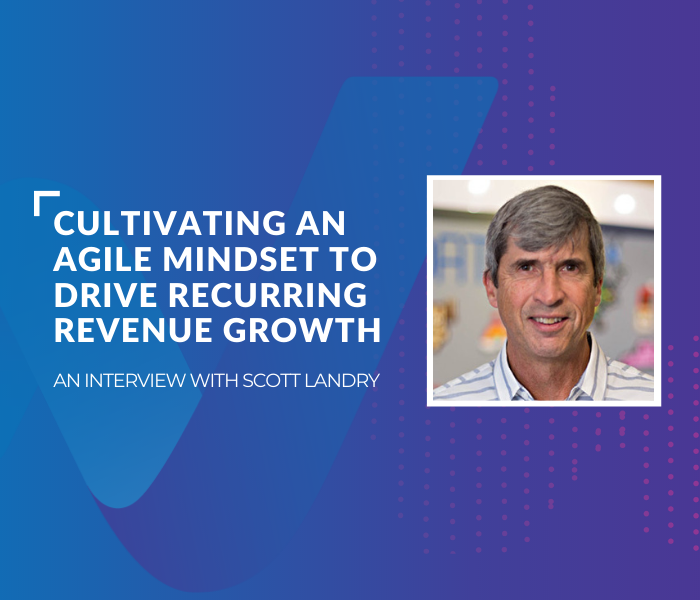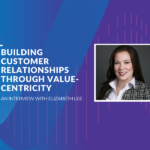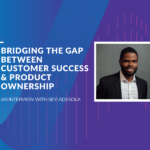Uniting Customer Success, Sales and Product Around An Agile Mindset
Today’s software leaders are quickly realizing the pivotal role that agility plays in building successful recurring revenue organizations and delivering customer value. In fact, 81% of C-suite executives agree that agility is critical to leading a successful organization (Forbes Insights, 2018). The challenge that many companies face, especially enterprise companies that have been around for 20+ years, is in implementing agility at all levels of the organization and uniting cross-functional teams around an agile mindset. Given this momentous objective , how can you cultivate an agile mindset in your organization?
To answer this question, I spoke with visionary leader and Valuize’s new President, Scott Landry. Scott has over two decades of experience leading enterprise customer success teams and transformations in the B2B software industry. During our conversation, Scott shared how his insights on creating and scaling market-leading customer success organizations and strategies to accelerate organization-wide agility, and how today’s software leaders can implement an agile mindset to drive recurring revenue growth.
Q: What was your first job and how did you get started in customer success?
“The first job I ever had was working in a Friendly’s Hamburger joint. I was in high school, so I got an early start working in the customer service environment. After college , I got in the engineering side of business and shifted to more customer-facing roles. I found that the stimulation of working with people was more enjoyable and that’s what took me to the service side of the software business.”
Q: How have you seen the customer success domain change since starting your career? How do you think the domain will continue to evolve?
“I was involved in a lot of tech support organizations in my early career and saw the transformation from a license-based model to a subscription-based model. Early on, I was involved in managing the maintenance revenue that was coming in which was very support related and most teams were focused on new sales or selling services and maintenance streams taken for granted. With SaaS models it shifted into taking care of a subscription stream, and support, services and account management became a new function called Success; a natural evolution as it went from the license side into much more of a service subscription model.
Customer Success came out of that evolution of learning how to sell and maintain in a subscription model, but also how to help customers be successful as opposed to just handling maintenance contracts. Adoption and usage became new buzz words.
Moving forward, the major evolution for the customer success domain is going to be self-service. The key part of subscription modelling is being able to make that transaction very smooth, easy and seamless for the customer. Customer success itself will continue to focus around understanding who customers are, how to interact with them and how to manage those relationships. Understanding how the customer works with your organization is the key to maintaining and growing revenue. In my experience, strong customer relationships are built through knowledge. So, being able to understand how customers are leveraging your solution and being successful with it is the ultimate outcome. If you understand that outcome, you can drive and evolve your solutions towards success in a self-service environment.
I think that’s ultimately where the domain will evolve; into seamless self-service that will make subscriptions valuable year in, year out.
Q: Can you tell us about your time serving as SVP Global Partner Success at Datto? What was your proudest accomplishment?
“I joined Datto while they were a very young, growing company and I helped them evolve and grow their support model and then the success organization. Initially, from an acquisition, they had two siloed teams; one was involved in the sales process and the other was focused on the renewal process. We brought these two teams together and transformed them into a single unit that looked at the overall objectives of Datto’s partners and what they needed to help grow their business. Our business model was sell-through so it was important to be close with the seller (our MSP) and work tightly aligned with our Sales organization. Together, we evaluated the entire life cycle through a journey mapping process in order to set up our customer success organization. We also went through a segmentation process to understand the needs of our different partners and what they needed from Datto. We used health scores with key attributes that could signal potential churn as our jumping off point and continued our transformation.
At Datto, it really was a transformation of how the organization operated and interfaced with our partners going forward. It was a unification of all of the partner-facing processes within the company to better understand how customer success could be that guiding north star. Customer success closely interfaced with both our partners and Sales team, then channeled that information back into the company in a very useful way. This cohesive motion helped sales sell more and helped the product team understand the best way to design products. Customer success was a key part of that mechanism that kept the ship sailing in a forward motion for our partners.”
Q: Why did you decide to join Valuize? What excites you most about joining Valuize?
“When we worked with Valuize at Datto, I saw the potential that Valuize had in its extensive customer success expertise and thought leadership. . Valuize fully understands the complexities of the problem at hand and knows how to help companies solve it. I think the most exciting part of joining the team is the fact that Valuize is a company that’s rooted in collaboration with their customers and their clients. Valuize is laser-focused on helping companies trailblaze a clear path to customer success as a superior end game. That’s what I’m super excited to get involved because this is something that I’m very passionate about: how customers can be successful, seeing the vision and how we can help companies take it to the next level.
I think Valuize will be a real game changer for a lot of clients, both on the enterprise side and even on some of the smaller startup companies. I think a lot of the things we’re doing will become institutionalized and become very successful at all levels of business. The potential is huge. On top of that, it’s a great group of people that are very passionate about this opportunity and can really accelerate how the domain evolves. Just great to work with folks who love their jobs”
Q: Based on your years of transforming businesses and CS teams, What piece of advice would you give CS leaders that are interested in building and scaling a successful customer success organization?
“Don’t be fearful of change. Set a 3-5 year vision of where you want to go. Once you set that vision, share it and collaborate internally to build consensus around it. This is how you really want your organization to transform. Once you have buy-in, work backwards and understand the steps you need to take to get there. It’s a process and it takes time to change but the vision drives the passion and will energize the team. That vision is always evolving, but it’s your north star. Subscription-based solutions are continuously evolving with customer expectations so your vision is what holds the transformation together and keeps people aligned through the change process. People don’t want to be left behind so this brings everyone forward chasing that ultimate goal.”
Q: What do you think are 3 important qualities a CS leader needs to have in order to be successful in 2021?
“First and foremost is agility. An agile mindset is key because, as we’ve talked about earlier, things change drastically all the time so being able to pivot and adapt is very important. I think the second essential piece is collaboration because any of the organizations, customers, and partners you work with will require collaboration and working together towards a solution. Lastly, I’d say you have to be technically oriented and push for a complete understanding of your customers. Business intelligence and managing customer data as it relates to understanding how your customers are using and leveraging your software is just as, if not more, important as the relationship side.”
Q: What do you think is the key to driving long-term B2B relationships with customers? How do you think other leaders can facilitate this?
“From a B2B lens, I think the biggest consideration for long term relationships is determining if the values you initially sold to a customer are still being understood and realized. As that relationship grows, you need to ask: have you extended that value? That’s where I’ve seen customer relationships stay the longest. The key accounts are the ones that you’re in touch with regularly and understand the best.
Just as we need to be agile, it’s important to remember that your customers all have to be agile as well. They’re moving quickly and your ability to move with them is what will sustain the relationship. Therefore, staying in tune with what customers need, what their goals are, and how they operate goes back to this concept of business intelligence. Are we delivering the value that our customers expected? And, if we are delivering that value, are we continuing to execute as things change? Are we continuing to measure that and stay in touch with customers’ needs? These are the questions that your organization needs to be asking constantly.
I think the worst thing that can happen to a relationship is when it gets stagnant. Whenever a customer relationship gets stagnant, I get very nervous. If your customers are renewing but you don’t understand why then they can be disengaged with the process. That’s scary because they might not be in tune with how your business can support them. It’s about renewing the value proposition with your customers continually, it can be done digitally but you need to be connecting.
Essentially, it’s about understanding the customer and what’s going on with their account at a fundamental level. The touchpoints of an account review can help you spot and identify areas that people are struggling with and get ahead of any potential issues. With this information, your organization will be empowered to properly support and prioritize the relationship.”
Q: Who’s a CS leader or organization that you currently admire?
“I’m part of a group that gets together monthly, there’s about 40 industry practitioners in it. For me, it’s been really interesting to hear the ideas and concepts that come from our discussions. I’m always super excited and energized from the amount of new and novel ideas that come from the group every time we get together.
One thing I’ve been particularly impressed by is the sheer initiatives that success organizations take, the holistic view of their customers and segments and the prescriptive approach they use to address each segment. These CS organizations are attacking the problem at the heart of understanding customers and building programs that are adaptive and scalable.
The leaders in this space are great problem solvers and they’re very passionate about what they do. There’s a tremendous amount of talent in customer success; in the early days, this was just a group that was filling a gap and now it’s a group that is leading the way. I think you’ll see more and more leaders coming out of success organizations that are going to turn into not only CCOs but our next COOs and CEOS because they do have the necessary skill set and full customer lifecycle knowledge to succeed. Rather than just calling out just one company or leader, I’d have to say I’ve been really inspired by the overall community that’s involved in customer success today.”
Q: What’s something you’ve learned about leading through change as an agile change agent throughout your career?
“An agile mindset is important because you have to be able to shift at a moment’s notice and make things work. A shift could be seismic or it could be very small but when you see that shift, you need to be able to guide your organization in the right direction.
I think COVID is a great example of where, during my time at Datto, we had to make a lot of sizable shifts around the nature of the business. Originally, there was an initial panic, like every company, about whether we would even be in business and what our business would look like as well as a focus on collections and billing part of our business. As things progressed and the economy looked better, we shifted to making sure what and how our MSPs (our Partners) and their customers (our end users) were doing by reaching out to them. You have to be ready to pivot at any point in time. If you have a team that’s continually growing and evolving, you have to be agile enough to spin something up and get programs back out into the field. I think a four week turnaround should be your target. Can you package and deliver a program to your clients in 4 weeks? It’s that quick.
In that light, one of the things I’ve done as a change agent in my career is create operations teams that are very agile on the back end as it allows your organization to adapt much more swiftly to market and customer needs.”
Q: What’s your favourite way to spend a Sunday?
“My favorite way to spend a Sunday would be starting on a golf course, playing 18 holes of golf (well). After that, riding my bike to the beach and hanging out there for the rest of the afternoon and ending with a cookout. That to me is the ultimate day. Of course that is the summer, winter is different as ski slopes are the best part of the day”
Optimize Recurring Revenue Growth Through An Agile Mindset
To take your customer success organization to the next level and cultivate an agile mindset, here are Scott’s 3 key takeaways to keep top of mind:
- Unite and align your organization around a vision that acts as your north star. This vision will evolve, as customers and subscription-based software change and grow, so continually adapting and adjusting that vision is the key to driving recurring revenue growth.
- Build an agile mindset into the foundation of your teams and operations. Creating teams that are agile on the back-end will ensure that your organization can respond to changes quickly and deliver solutions as the industry evolves. Embrace change.
- Just as businesses are, and need to be, agile, so are your customers. Customer needs, interactions and sentiment are dynamic and constantly changing . Organizations that prioritize knowing their customers through customer interactions, more personal one-on-ones or through account reviews, and evolving their processes and business intelligence as a result of that knowledge will be the ones that successfully help their customers achieve success. I once heard it described as “know your customers better than they know themselves!”
With these insights to drive your customer success initiatives forward, you’re on the right track to accelerate recurring revenue growth.
If you’re ready to supercharge your organization’s customer success, sales and product through an agile mindset, contact Valuize for expert guidance from Scott and the Valuize team.





